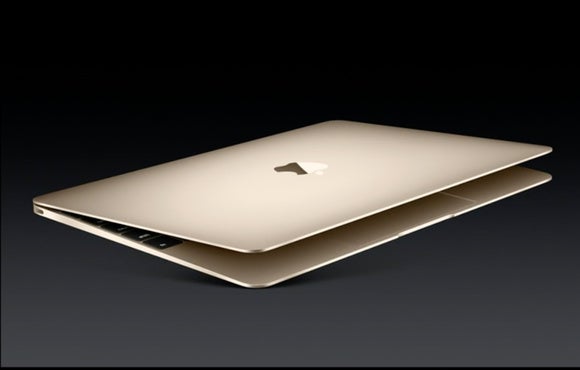When Apple announced the new 12-inch MacBook this week, all eyes were on its superthin design -- it's thinner than the MacBook Air every PC has emulated for years. But in many ways, the new MacBook is more iPad than laptop.
No, the MacBook 12 doesn't have a touchscreen, and it uses a traditional attached keyboard. But in addition to its standard audio jack, it has only one port: a USB-C port that is more similar to the iPad's Lightning port than the MacBooks' Thunderbolt port. The new MacBook is mainly screen and battery, with a tiny motherboard inside -- like an iPad Air. It comes in the same three colors as the iPad, and it features a new touchpad that favors the use of iPad-like gestures.
It's the move to USB-C that makes the new MacBook so iPad-like. It's only one port, which does less than other MacBooks' panoply of ports.
With Thunderbolt, you could connect a MacBook Air or Pro to an Apple Thunderbolt Display or to a third-party Thunderbolt dock that would in turn connect to a variety of peripherals, such as wired Ethernet, USB devices like iPads and iPhones (for both charging and syncing), and backup drives (whether FireWire or USB). That lets you convert your MacBook Air or Pro into a workstation, without the port profusion common to PCs.
Not so with the MacBook 12 -- its USB-C port may, through adapters, connect to a variety of USB, VGA, HDMI, and DisplayPort devices, as well as to a power source. However, you can do so only one at a time, unless you pay $79 for an Apple Multiport adapter that supports three simultaneous connections: USB-C (such as for power), USB, and video (HDMI or VGA, depending on model) -- but not Thunderbolt, which every other current and recent Mac model supports.
If you spent $1,000 on a Thunderbolt Display, you're screwed; it does not work as either a monitor or a dock with the MacBook 12. You can use an older Cinema Display or any VGA HDMI, or DisplayPort monitor with the MacBook 12, but you can't use a Thunderbolt (or FireWire) device with it, such as the Thunderbolt Display or pro-class storage devices. Even if Apple comes out with a Thunderbolt Display-like USB-C hub-equipped monitor, all existing (and expensive) Apple displays and third-party hubs are orphaned.
If you want to back up your MacBook 12, you have to use a Multiport adapter (for USB drives only) or use a wireless backup drive, which is slow and competes with your other wireless devices (including the MacBook 12 itself) for bandwidth. You also have to hope your power lasts as long as your backup job.
If you want to update your iPad or iPhone via a USB connection, which iTunes supports for both backup and software update installs, you have to again remove whatever is plugged into the USB-C port or use a Multiport adapter to connect the iOS device. You can do this over Wi-Fi, but the truth is that Wi-Fi syncing on iOS devices is not as reliable or automatic as it is over a wired connection.
If you want to transfer pictures from your camera or an SD card, you need again to unplug whatever is in the USB-C port and plug in the appropriate cable or adapter, or use a Multiport adapter (again, for USB). Ditto if you want to watch a DVD (yes, that still happens).
If you want to use a keyboard with a numeric keypad, you need to unplug whatever is in that USB-C port to connect the required wired keyboard. (Sorry, the few wireless numeric keypads work poorly.)
If you have an iPad, you already deal with this reality: You can connect one adapter into the Dock or Lightning port, so you can sync with your computer over USB, or you can download photos from your camera, or you can mirror the screen via HDMI or VGA, or you can connect some other peripheral.
if you're a serious iPadder, that means you probably have an bag of adapters you carry with you. I don't want to keep track of such a collection on my desk, and I resent having to buy a $79 adapter for basic connectivity.
It shouldn't have been hard for Apple to add a Thunderbolt port as a backup connector for the world of today in addition to the USB-C connector of tomorrow.
All of this is why I see the MacBook more as a type of iPad than a laptop. It's really designed for stand-alone use, not as part of an ecosystem of peripherals. Apple seems to think we'll do everything on our MacBooks over Wi-Fi and Bluetooth, as we do on our iPads. But that's not so smart an assumption.
Wireless capacity is limited, and as we move storage transfer and perhaps at some point display transmission to Wi-Fi, we're going to have real slowdowns in the typical tech-savvy home or white-collar office. Computers deal with more data than tablets do.
Because the MacBook 12 is like an iPad -- a great, largely self-contained adjunct on the road -- it's not the kind of workstation we're used to having on our desks.
Apple may think it's time to cut all the cords, but I disagree. We're not there yet, if we ever will be. The MacBook 12 is a very sexy laptop, but not one I can recommend. It's not as practical as it needs to be.






